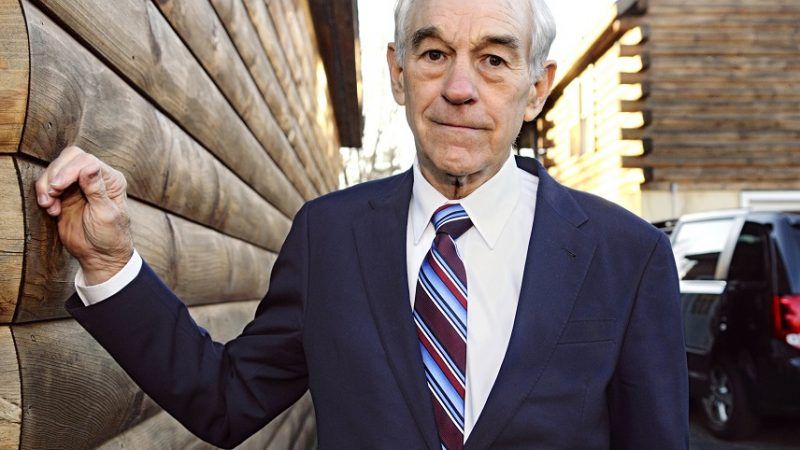How Alexander Hamilton Screwed Up America
The foreword to a new history of our controversial Founder written by Ron Paul.

Having now endured a more than two-year orgy of adoration for the Broadway hip-hop musical, Hamilton, the public surely deserves a historical corrective. Historian Brion McClanahan's latest work on the Revolutionary period, How Alexander Hamilton Screwed Up America, is being released Monday.
Ron Paul, the Libertarian and Republican candidate for president and longtime U.S. Representative from Texas, has written the foreword, which he graciously shared in advance with Reason.
The central government has always been the greatest threat to liberty in America, but most Americans don't understand how modern America became the warfare state. How did the president acquire so much unconstitutional power? How did the federal judiciary become, at times, the most powerful branch of government? How were the states reduced to mere corporations of the general government? Why is every issue, from abortion to bathrooms to crime to education, a "national" problem? The people have very little input into public policy. They vote, they rally, they attend "town hall" meetings, but it does very little to stop the avalanche of federal laws, regulations, and rules that affect every aspect of American life. We have a federal leviathan that can't be tamed, and Americans are angry about it. They want answers.
Certainly, the Framers of the Constitution did not design our system this way. They intended the checks and balances between the three branches of government and also between the states and the central government to limit the potential for abuse, but somewhere along the way that changed. Who or what changed the system? It wasn't Barack Obama or George W. Bush. It wasn't even Franklin Roosevelt, his cousin Teddy, or Woodrow Wilson. They certainly helped, but as Brion McClanahan argues in the following pages, the architects of our nationalist nightmare were none other than Alexander Hamilton and a trio of Supreme Court justices: John Marshall, Joseph Story, and Hugo Black. Identifying the source of the problem is essential for correcting it.
Hamilton has become one of the more popular figures in America for the Left and the Right, so accusing him of making a mess of the United States is certainly shocking. But it is also accurate. Hamilton's constitutional machinations created the outline for literally every unconstitutional federal act, from executive and judicial overreach to the nationalization of every political issue in the country. He lied to the American public about his true intentions before the Constitution was ratified and then used sly doublespeak to persuade others that so-called "implied powers" were part of the plan from the beginning. We would not have abusive unilateral executive authority in foreign and domestic policy, dangerous central banking, and impotent state governments without Hamilton's guidance. Hamilton is the architect of big government in America.
Marshall, Story, and Black certainly acted as co-conspirators. Marshall's landmark decisions could have been written by Hamilton. His reading of the Constitution was at odds with how the document was explained to the state ratifying conventions in 1788. Marshall's interpretation would have led the people to reject the document. His belief in federal judicial supremacy and unchecked national authority has been the keystone to every subsequent outrageous federal ruling, from Roe v. Wade to NIFB v. Sebelius. Marshall is the reason the Supreme Court now takes center stage in every political debate in America, but he did not accomplish this alone.
Marshall's protégé and right hand man Joseph Story codified Marshall's vision for federal judicial supremacy as a popular legal scholar and law professor. Even today, law students across the country are taught Story's version of federal power. Story's message is simple: the federal government is supreme (even if it isn't), the state governments are subservient to the central authority, and the federal court system is the final arbiter in all constitutional questions. When these law students become lawyers and judges, they echo Story's teachings. With a legal profession so infested with a version of American political history contradictory to the actual record, it is no wonder the federal judiciary has become a mere rubber stamp in the expansion of federal power.
Black put the finishing touches on the Hamiltonian coup. As a member of the Supreme Court in the mid-twentieth century, Black participated in the final transformation of America from a federal union that respected state powers to a unitary state with unlimited control over the lives of individual Americans. You can't pray in public schools, control who uses public bathrooms, regulate pornography, or keep common standards of public decency because of Hugo Black. His insistence that the majority of the people of the states had very little influence over the social standards of their own communities delivered a death blow to the original Constitution. Thanks to Black, Americans now believe every issue is national, no matter how local in scope.
McClanahan has done a service to those who love liberty and respect the original Constitution as drafted and ratified by the founding generation. By knowing how we went wrong and who drove America off the rails, Americans can begin to repair the damage done to our political system. Unrestrained nationalism is a curse, but there is an antidote: liberty and federalism. If we start to cultivate liberty and freedom in our own communities and insist that our elected officials pursue the same agenda by disengaging the general government from Hamilton's desire for unchecked national power, we could salvage real America from the ruins of Hamilton's America. Education is the first step, and reading this book is a nice place to start.


Show Comments (91)